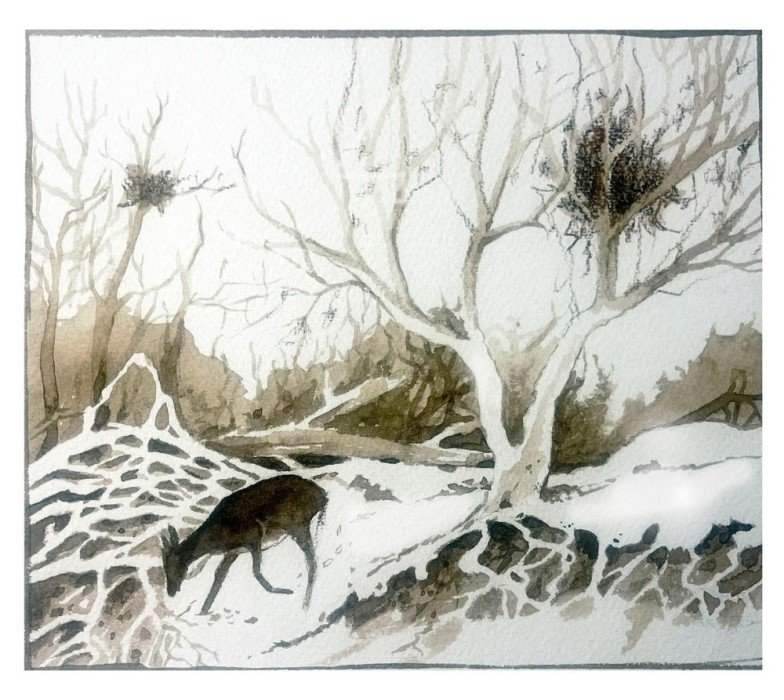Squirrel dreys are much more than nests
February 15, 2025 | By Emily Haynes | The Outside StoryIllustration by Adelaide Murphy Tyrol
In the starkness of winter, squirrel dreys reveal themselves in the tree canopy. They’ve been there all along — just screened by trees’ leafy crowns for much of the year.
Dreys are shaggy masses of leaves nestled against a tree trunk or cupped in a fork of branches 20 to 40 feet above the ground. Squirrels not only rear their kits in them, but also use them as shelter during many months of the year.
“It’s always kind of magical when the leaves fall down and you see these other homes of citizens in the neighborhood,” says Ken Benton, director of education at North Branch Nature Center in Montpelier.
Roughly one to two feet in diameter, dreys are often mistaken for the nests of large birds such as eagles and hawks. But while those birds prefer platform-style nests made primarily of sticks, squirrels make their shelters out of leaves, grass, and shredded tree bark. Crows’ nests are similar in size and location to squirrel dreys but use pencil-length sticks to form an open cup. Squirrel dreys, on the other hand, are fully enclosed; squirrels typically make the entrance small and flush with a tree trunk or branch.
What’s more, dreys are more multipurpose than nests. Birds typically inhabit their nests only from the time they lay eggs through when their young have fledged. Squirrels, however, can be found sleeping and resting in dreys throughout the year — making dreys longer-lasting home bases.
“For the most part, they’re taking shelter from nocturnal predators, like owls. A sleeping squirrel would be an easy and tasty snack for a large owl,” says Nate Marchessault, staff ecologist at the Harris Center for Conservation Education in Hancock, New Hampshire.
In the Northeast, all squirrel species — grey, red, and flying — make dreys, but grey squirrel dreys are the easiest to spot. That’s because red squirrels prefer to build theirs in pines and other coniferous trees, while grey squirrels go for deciduous trees. Flying squirrels tend to build smaller nests, often in conifers. Sit and watch a grey squirrel for a while and it will likely lead you to its drey, scampering up a tree trunk — perhaps with fresh nest lining clamped between its teeth — and disappearing into its shaggy home. Flying squirrels, however, are nocturnal, so it’s much more difficult to find where they shelter from predators and the elements.
Grey squirrel dreys are made up of three distinct layers. An outer layer of sticks and leaves helps insulate the cavity from water and wind. This is what’s visible to us from ground level. Within that is a layer of young, pliable shoots, which squirrels gnaw off trees and weave into a round cavity. It’s this cavity where squirrels will rest, sleep, and raise their young, so they line it with suitably soft material, such as feathers, fur, and grasses. (I’ve even spotted a cotton rag hanging from an abandoned squirrel drey!)
“They really like it cozy in the middle of their dreys,” Marchessault said.
Now in mid-winter, squirrels have mostly abandoned their dreys for the more effective shelter of tree hollows. These cavities — some bored by woodpeckers and others formed naturally, such as after a tree limb falls — are better water-proofed and wind-proofed, and help squirrels stay protected during the coldest and snowiest months of the year. Squirrels like to spruce up these cavities by lining them with the same materials they use to line their dreys. If squirrels can’t find a suitable cavity to overwinter, they’ll remain in their dreys, sometimes huddling together to stay warm.
Grey squirrels birth two litters of kits each year: once between January and February and the other in late summer. The winter litter may be raised in cozier tree cavities or more exposed dreys, and the summer kits will be raised in dreys.
During winter ecology lessons with children, Benton encourages them to canvass their neighborhoods and count the number of squirrel shelters temporarily on view. The next time you’re outside, see how many dreys you can spot.
Though the squirrel that built it may be napping in a tree cavity instead, if you see rustling, the occupant may not have found a warmer spot to spend the winter.
Emily Haynes is a writer currently living in Washington, D.C. An avid birder and hiker, she loves exploring the forests of the Northeast. The Outside Story is assigned and edited by Northern Woodlands magazine and sponsored by the Wellborn Ecology Fund of New Hampshire Charitable Foundation.

